Economic Evaluation
VerifiedAdded on 2022/12/23
|13
|3357
|70
AI Summary
Economic evaluation is a crucial tool in healthcare decision making and resource allocation. It helps decision makers determine the value for money and prioritize interventions. This document discusses the importance of economic evaluation in healthcare outcomes, feasibility assessments, and efficiency of health interventions. It also explores different types of economic evaluations and their applications.
Contribute Materials
Your contribution can guide someone’s learning journey. Share your
documents today.

1
Economic Evaluation
Name
School-Affiliated
Economic Evaluation
Name
School-Affiliated
Secure Best Marks with AI Grader
Need help grading? Try our AI Grader for instant feedback on your assignments.
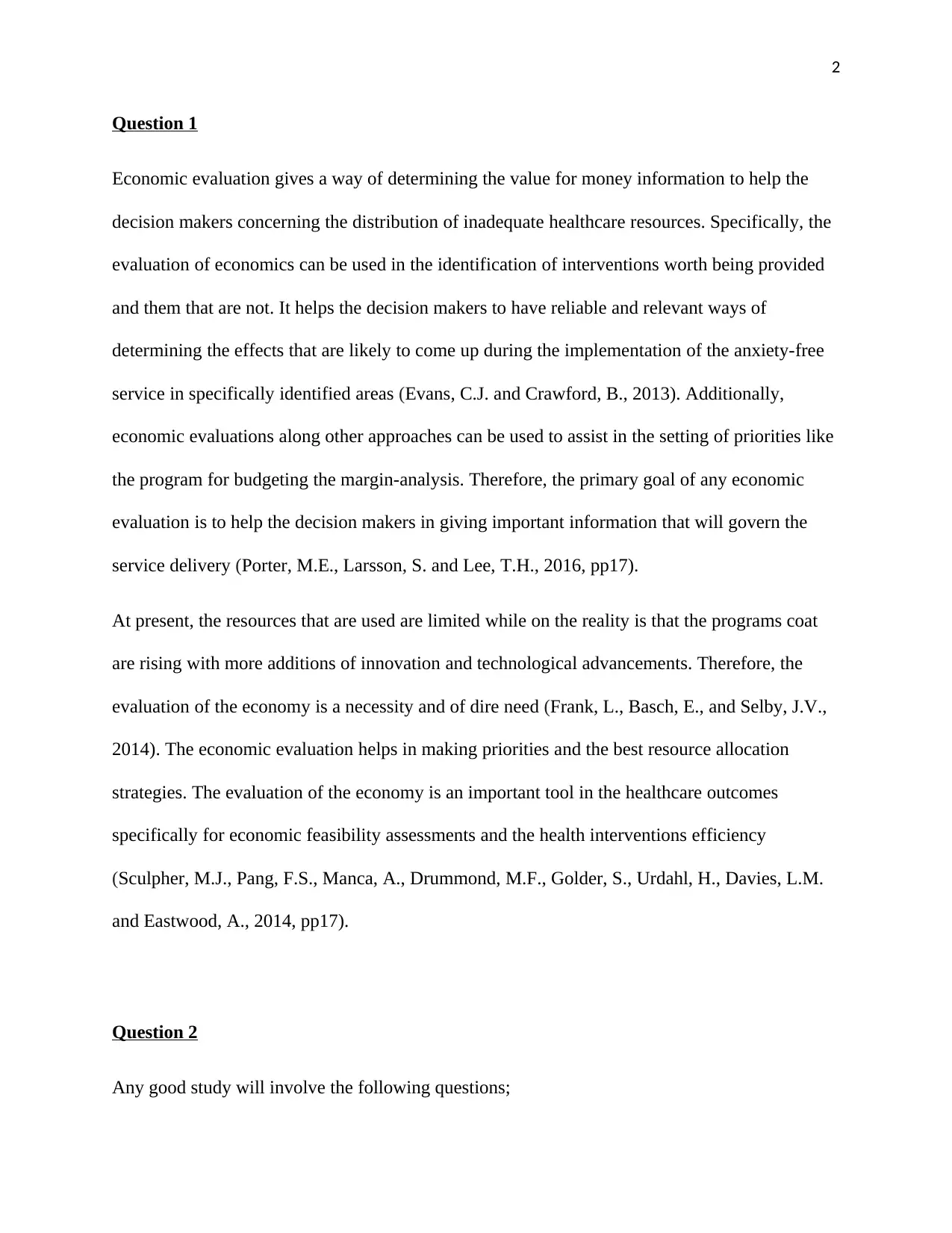
2
Question 1
Economic evaluation gives a way of determining the value for money information to help the
decision makers concerning the distribution of inadequate healthcare resources. Specifically, the
evaluation of economics can be used in the identification of interventions worth being provided
and them that are not. It helps the decision makers to have reliable and relevant ways of
determining the effects that are likely to come up during the implementation of the anxiety-free
service in specifically identified areas (Evans, C.J. and Crawford, B., 2013). Additionally,
economic evaluations along other approaches can be used to assist in the setting of priorities like
the program for budgeting the margin-analysis. Therefore, the primary goal of any economic
evaluation is to help the decision makers in giving important information that will govern the
service delivery (Porter, M.E., Larsson, S. and Lee, T.H., 2016, pp17).
At present, the resources that are used are limited while on the reality is that the programs coat
are rising with more additions of innovation and technological advancements. Therefore, the
evaluation of the economy is a necessity and of dire need (Frank, L., Basch, E., and Selby, J.V.,
2014). The economic evaluation helps in making priorities and the best resource allocation
strategies. The evaluation of the economy is an important tool in the healthcare outcomes
specifically for economic feasibility assessments and the health interventions efficiency
(Sculpher, M.J., Pang, F.S., Manca, A., Drummond, M.F., Golder, S., Urdahl, H., Davies, L.M.
and Eastwood, A., 2014, pp17).
Question 2
Any good study will involve the following questions;
Question 1
Economic evaluation gives a way of determining the value for money information to help the
decision makers concerning the distribution of inadequate healthcare resources. Specifically, the
evaluation of economics can be used in the identification of interventions worth being provided
and them that are not. It helps the decision makers to have reliable and relevant ways of
determining the effects that are likely to come up during the implementation of the anxiety-free
service in specifically identified areas (Evans, C.J. and Crawford, B., 2013). Additionally,
economic evaluations along other approaches can be used to assist in the setting of priorities like
the program for budgeting the margin-analysis. Therefore, the primary goal of any economic
evaluation is to help the decision makers in giving important information that will govern the
service delivery (Porter, M.E., Larsson, S. and Lee, T.H., 2016, pp17).
At present, the resources that are used are limited while on the reality is that the programs coat
are rising with more additions of innovation and technological advancements. Therefore, the
evaluation of the economy is a necessity and of dire need (Frank, L., Basch, E., and Selby, J.V.,
2014). The economic evaluation helps in making priorities and the best resource allocation
strategies. The evaluation of the economy is an important tool in the healthcare outcomes
specifically for economic feasibility assessments and the health interventions efficiency
(Sculpher, M.J., Pang, F.S., Manca, A., Drummond, M.F., Golder, S., Urdahl, H., Davies, L.M.
and Eastwood, A., 2014, pp17).
Question 2
Any good study will involve the following questions;
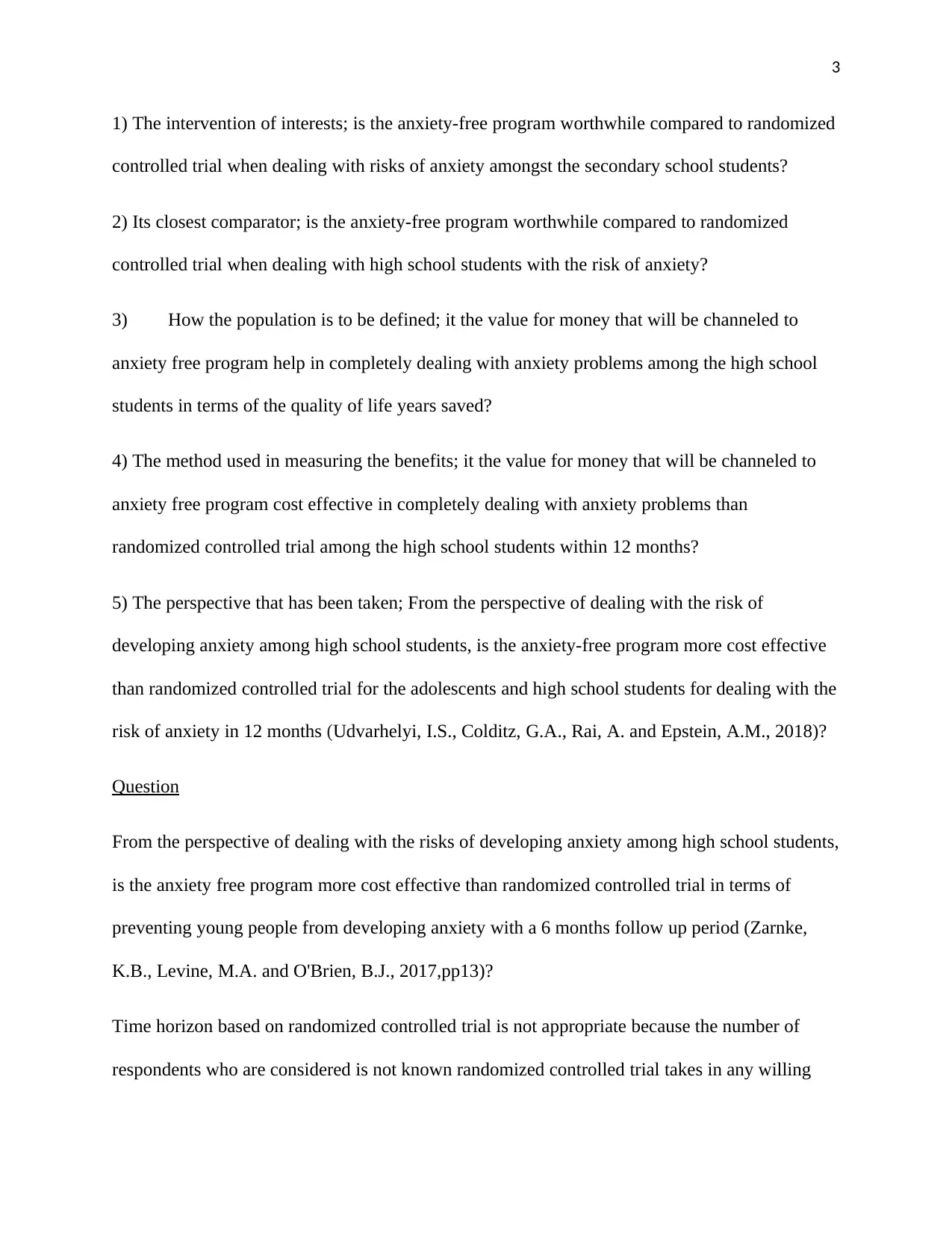
3
1) The intervention of interests; is the anxiety-free program worthwhile compared to randomized
controlled trial when dealing with risks of anxiety amongst the secondary school students?
2) Its closest comparator; is the anxiety-free program worthwhile compared to randomized
controlled trial when dealing with high school students with the risk of anxiety?
3) How the population is to be defined; it the value for money that will be channeled to
anxiety free program help in completely dealing with anxiety problems among the high school
students in terms of the quality of life years saved?
4) The method used in measuring the benefits; it the value for money that will be channeled to
anxiety free program cost effective in completely dealing with anxiety problems than
randomized controlled trial among the high school students within 12 months?
5) The perspective that has been taken; From the perspective of dealing with the risk of
developing anxiety among high school students, is the anxiety-free program more cost effective
than randomized controlled trial for the adolescents and high school students for dealing with the
risk of anxiety in 12 months (Udvarhelyi, I.S., Colditz, G.A., Rai, A. and Epstein, A.M., 2018)?
Question
From the perspective of dealing with the risks of developing anxiety among high school students,
is the anxiety free program more cost effective than randomized controlled trial in terms of
preventing young people from developing anxiety with a 6 months follow up period (Zarnke,
K.B., Levine, M.A. and O'Brien, B.J., 2017,pp13)?
Time horizon based on randomized controlled trial is not appropriate because the number of
respondents who are considered is not known randomized controlled trial takes in any willing
1) The intervention of interests; is the anxiety-free program worthwhile compared to randomized
controlled trial when dealing with risks of anxiety amongst the secondary school students?
2) Its closest comparator; is the anxiety-free program worthwhile compared to randomized
controlled trial when dealing with high school students with the risk of anxiety?
3) How the population is to be defined; it the value for money that will be channeled to
anxiety free program help in completely dealing with anxiety problems among the high school
students in terms of the quality of life years saved?
4) The method used in measuring the benefits; it the value for money that will be channeled to
anxiety free program cost effective in completely dealing with anxiety problems than
randomized controlled trial among the high school students within 12 months?
5) The perspective that has been taken; From the perspective of dealing with the risk of
developing anxiety among high school students, is the anxiety-free program more cost effective
than randomized controlled trial for the adolescents and high school students for dealing with the
risk of anxiety in 12 months (Udvarhelyi, I.S., Colditz, G.A., Rai, A. and Epstein, A.M., 2018)?
Question
From the perspective of dealing with the risks of developing anxiety among high school students,
is the anxiety free program more cost effective than randomized controlled trial in terms of
preventing young people from developing anxiety with a 6 months follow up period (Zarnke,
K.B., Levine, M.A. and O'Brien, B.J., 2017,pp13)?
Time horizon based on randomized controlled trial is not appropriate because the number of
respondents who are considered is not known randomized controlled trial takes in any willing
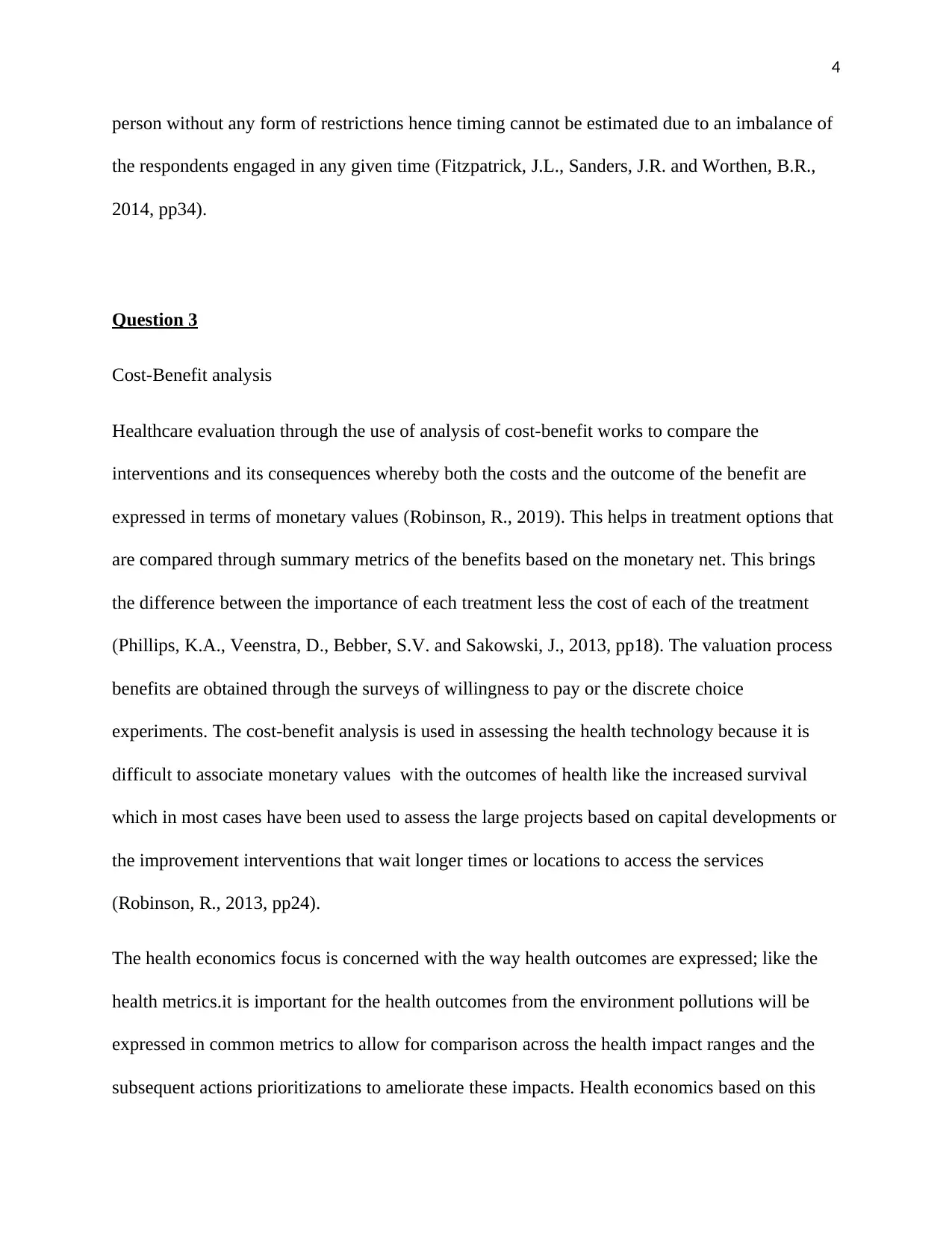
4
person without any form of restrictions hence timing cannot be estimated due to an imbalance of
the respondents engaged in any given time (Fitzpatrick, J.L., Sanders, J.R. and Worthen, B.R.,
2014, pp34).
Question 3
Cost-Benefit analysis
Healthcare evaluation through the use of analysis of cost-benefit works to compare the
interventions and its consequences whereby both the costs and the outcome of the benefit are
expressed in terms of monetary values (Robinson, R., 2019). This helps in treatment options that
are compared through summary metrics of the benefits based on the monetary net. This brings
the difference between the importance of each treatment less the cost of each of the treatment
(Phillips, K.A., Veenstra, D., Bebber, S.V. and Sakowski, J., 2013, pp18). The valuation process
benefits are obtained through the surveys of willingness to pay or the discrete choice
experiments. The cost-benefit analysis is used in assessing the health technology because it is
difficult to associate monetary values with the outcomes of health like the increased survival
which in most cases have been used to assess the large projects based on capital developments or
the improvement interventions that wait longer times or locations to access the services
(Robinson, R., 2013, pp24).
The health economics focus is concerned with the way health outcomes are expressed; like the
health metrics.it is important for the health outcomes from the environment pollutions will be
expressed in common metrics to allow for comparison across the health impact ranges and the
subsequent actions prioritizations to ameliorate these impacts. Health economics based on this
person without any form of restrictions hence timing cannot be estimated due to an imbalance of
the respondents engaged in any given time (Fitzpatrick, J.L., Sanders, J.R. and Worthen, B.R.,
2014, pp34).
Question 3
Cost-Benefit analysis
Healthcare evaluation through the use of analysis of cost-benefit works to compare the
interventions and its consequences whereby both the costs and the outcome of the benefit are
expressed in terms of monetary values (Robinson, R., 2019). This helps in treatment options that
are compared through summary metrics of the benefits based on the monetary net. This brings
the difference between the importance of each treatment less the cost of each of the treatment
(Phillips, K.A., Veenstra, D., Bebber, S.V. and Sakowski, J., 2013, pp18). The valuation process
benefits are obtained through the surveys of willingness to pay or the discrete choice
experiments. The cost-benefit analysis is used in assessing the health technology because it is
difficult to associate monetary values with the outcomes of health like the increased survival
which in most cases have been used to assess the large projects based on capital developments or
the improvement interventions that wait longer times or locations to access the services
(Robinson, R., 2013, pp24).
The health economics focus is concerned with the way health outcomes are expressed; like the
health metrics.it is important for the health outcomes from the environment pollutions will be
expressed in common metrics to allow for comparison across the health impact ranges and the
subsequent actions prioritizations to ameliorate these impacts. Health economics based on this
Secure Best Marks with AI Grader
Need help grading? Try our AI Grader for instant feedback on your assignments.
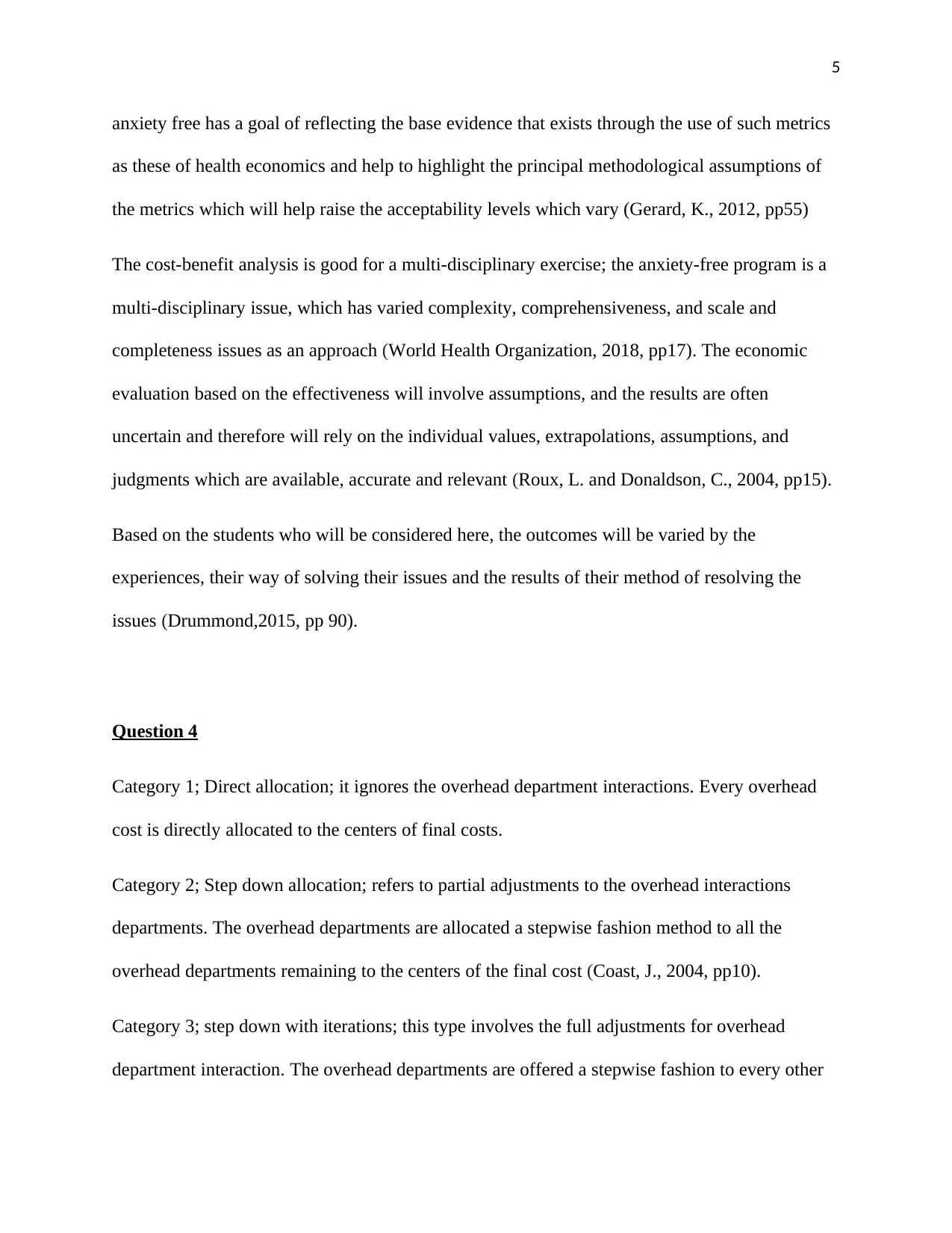
5
anxiety free has a goal of reflecting the base evidence that exists through the use of such metrics
as these of health economics and help to highlight the principal methodological assumptions of
the metrics which will help raise the acceptability levels which vary (Gerard, K., 2012, pp55)
The cost-benefit analysis is good for a multi-disciplinary exercise; the anxiety-free program is a
multi-disciplinary issue, which has varied complexity, comprehensiveness, and scale and
completeness issues as an approach (World Health Organization, 2018, pp17). The economic
evaluation based on the effectiveness will involve assumptions, and the results are often
uncertain and therefore will rely on the individual values, extrapolations, assumptions, and
judgments which are available, accurate and relevant (Roux, L. and Donaldson, C., 2004, pp15).
Based on the students who will be considered here, the outcomes will be varied by the
experiences, their way of solving their issues and the results of their method of resolving the
issues (Drummond,2015, pp 90).
Question 4
Category 1; Direct allocation; it ignores the overhead department interactions. Every overhead
cost is directly allocated to the centers of final costs.
Category 2; Step down allocation; refers to partial adjustments to the overhead interactions
departments. The overhead departments are allocated a stepwise fashion method to all the
overhead departments remaining to the centers of the final cost (Coast, J., 2004, pp10).
Category 3; step down with iterations; this type involves the full adjustments for overhead
department interaction. The overhead departments are offered a stepwise fashion to every other
anxiety free has a goal of reflecting the base evidence that exists through the use of such metrics
as these of health economics and help to highlight the principal methodological assumptions of
the metrics which will help raise the acceptability levels which vary (Gerard, K., 2012, pp55)
The cost-benefit analysis is good for a multi-disciplinary exercise; the anxiety-free program is a
multi-disciplinary issue, which has varied complexity, comprehensiveness, and scale and
completeness issues as an approach (World Health Organization, 2018, pp17). The economic
evaluation based on the effectiveness will involve assumptions, and the results are often
uncertain and therefore will rely on the individual values, extrapolations, assumptions, and
judgments which are available, accurate and relevant (Roux, L. and Donaldson, C., 2004, pp15).
Based on the students who will be considered here, the outcomes will be varied by the
experiences, their way of solving their issues and the results of their method of resolving the
issues (Drummond,2015, pp 90).
Question 4
Category 1; Direct allocation; it ignores the overhead department interactions. Every overhead
cost is directly allocated to the centers of final costs.
Category 2; Step down allocation; refers to partial adjustments to the overhead interactions
departments. The overhead departments are allocated a stepwise fashion method to all the
overhead departments remaining to the centers of the final cost (Coast, J., 2004, pp10).
Category 3; step down with iterations; this type involves the full adjustments for overhead
department interaction. The overhead departments are offered a stepwise fashion to every other
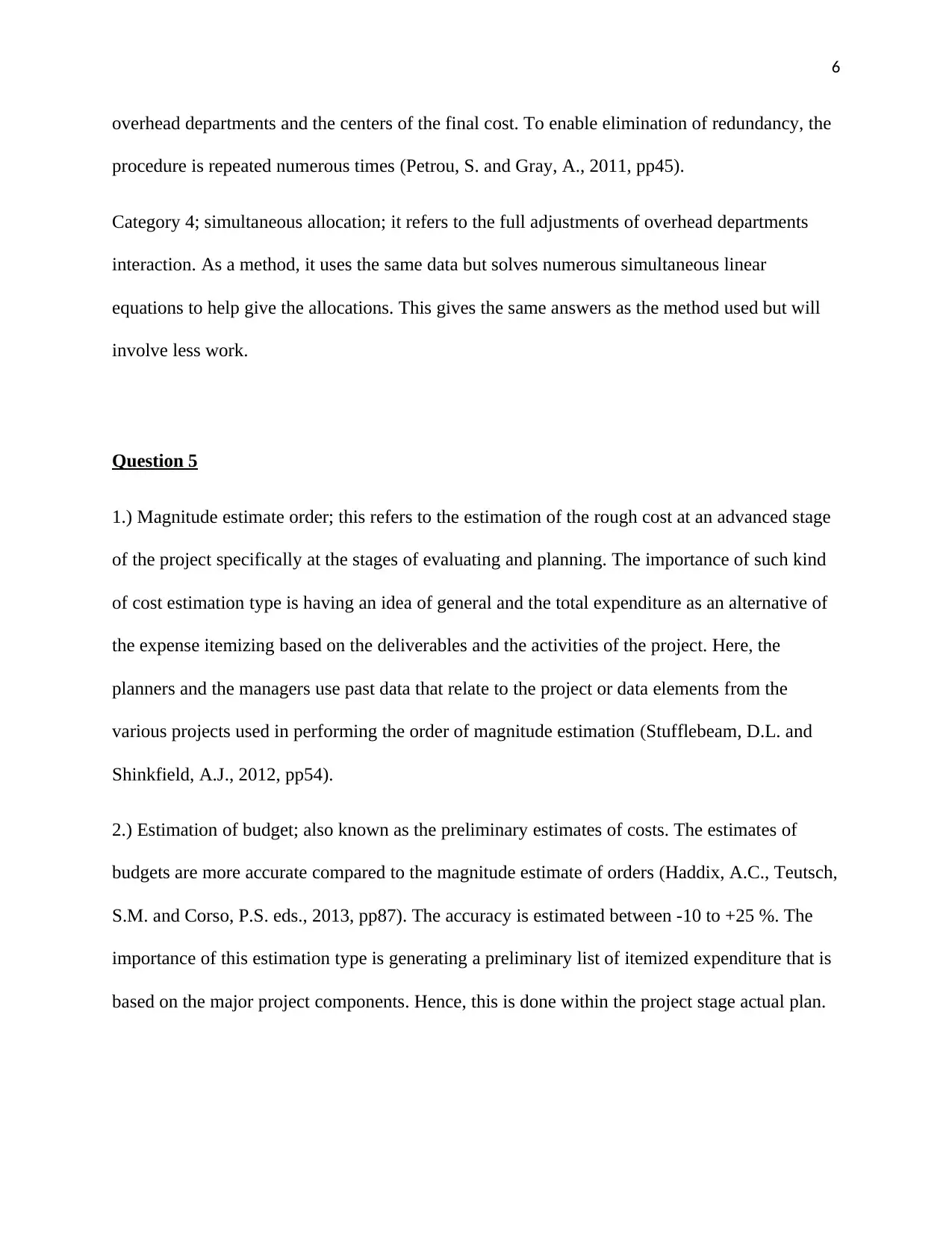
6
overhead departments and the centers of the final cost. To enable elimination of redundancy, the
procedure is repeated numerous times (Petrou, S. and Gray, A., 2011, pp45).
Category 4; simultaneous allocation; it refers to the full adjustments of overhead departments
interaction. As a method, it uses the same data but solves numerous simultaneous linear
equations to help give the allocations. This gives the same answers as the method used but will
involve less work.
Question 5
1.) Magnitude estimate order; this refers to the estimation of the rough cost at an advanced stage
of the project specifically at the stages of evaluating and planning. The importance of such kind
of cost estimation type is having an idea of general and the total expenditure as an alternative of
the expense itemizing based on the deliverables and the activities of the project. Here, the
planners and the managers use past data that relate to the project or data elements from the
various projects used in performing the order of magnitude estimation (Stufflebeam, D.L. and
Shinkfield, A.J., 2012, pp54).
2.) Estimation of budget; also known as the preliminary estimates of costs. The estimates of
budgets are more accurate compared to the magnitude estimate of orders (Haddix, A.C., Teutsch,
S.M. and Corso, P.S. eds., 2013, pp87). The accuracy is estimated between -10 to +25 %. The
importance of this estimation type is generating a preliminary list of itemized expenditure that is
based on the major project components. Hence, this is done within the project stage actual plan.
overhead departments and the centers of the final cost. To enable elimination of redundancy, the
procedure is repeated numerous times (Petrou, S. and Gray, A., 2011, pp45).
Category 4; simultaneous allocation; it refers to the full adjustments of overhead departments
interaction. As a method, it uses the same data but solves numerous simultaneous linear
equations to help give the allocations. This gives the same answers as the method used but will
involve less work.
Question 5
1.) Magnitude estimate order; this refers to the estimation of the rough cost at an advanced stage
of the project specifically at the stages of evaluating and planning. The importance of such kind
of cost estimation type is having an idea of general and the total expenditure as an alternative of
the expense itemizing based on the deliverables and the activities of the project. Here, the
planners and the managers use past data that relate to the project or data elements from the
various projects used in performing the order of magnitude estimation (Stufflebeam, D.L. and
Shinkfield, A.J., 2012, pp54).
2.) Estimation of budget; also known as the preliminary estimates of costs. The estimates of
budgets are more accurate compared to the magnitude estimate of orders (Haddix, A.C., Teutsch,
S.M. and Corso, P.S. eds., 2013, pp87). The accuracy is estimated between -10 to +25 %. The
importance of this estimation type is generating a preliminary list of itemized expenditure that is
based on the major project components. Hence, this is done within the project stage actual plan.
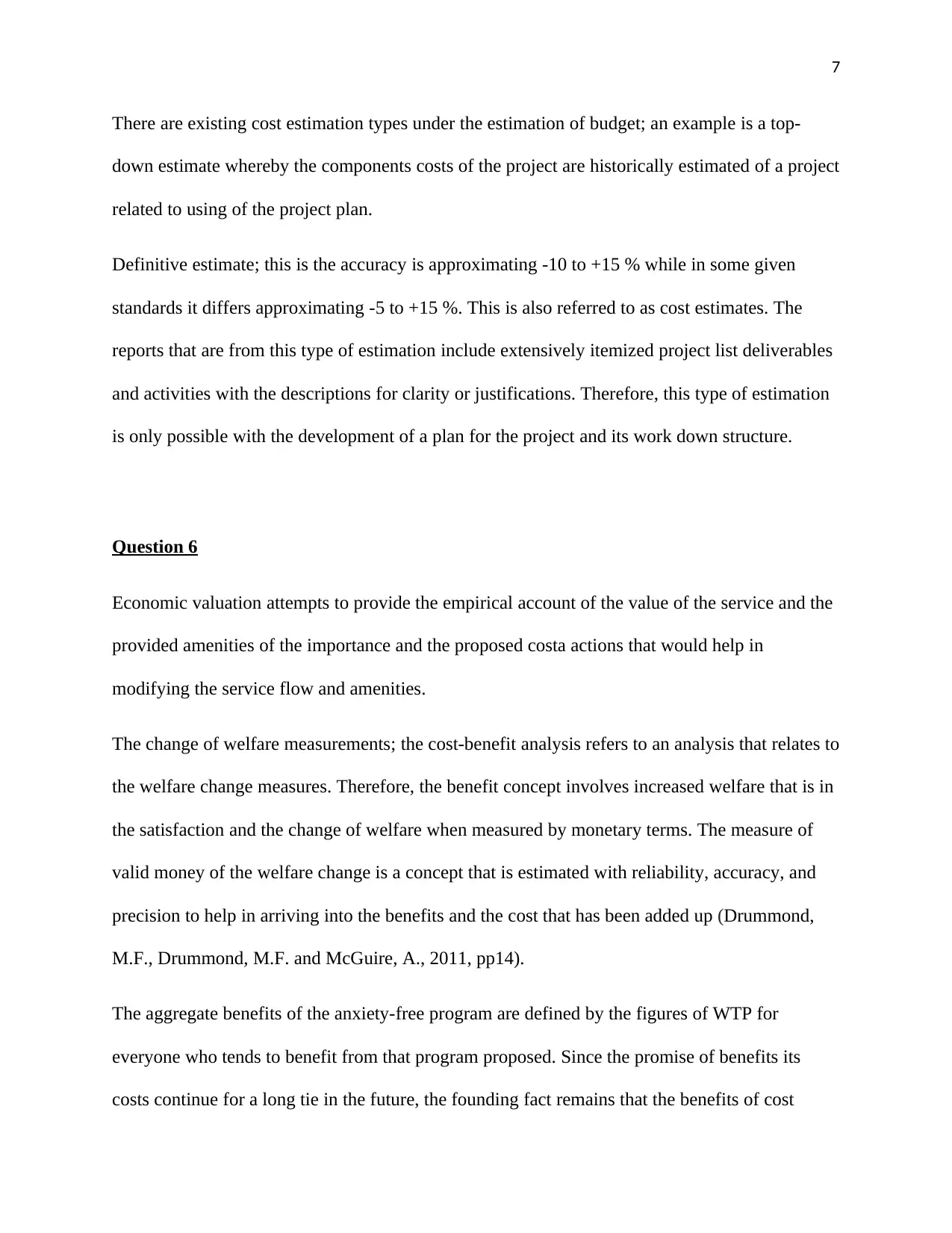
7
There are existing cost estimation types under the estimation of budget; an example is a top-
down estimate whereby the components costs of the project are historically estimated of a project
related to using of the project plan.
Definitive estimate; this is the accuracy is approximating -10 to +15 % while in some given
standards it differs approximating -5 to +15 %. This is also referred to as cost estimates. The
reports that are from this type of estimation include extensively itemized project list deliverables
and activities with the descriptions for clarity or justifications. Therefore, this type of estimation
is only possible with the development of a plan for the project and its work down structure.
Question 6
Economic valuation attempts to provide the empirical account of the value of the service and the
provided amenities of the importance and the proposed costa actions that would help in
modifying the service flow and amenities.
The change of welfare measurements; the cost-benefit analysis refers to an analysis that relates to
the welfare change measures. Therefore, the benefit concept involves increased welfare that is in
the satisfaction and the change of welfare when measured by monetary terms. The measure of
valid money of the welfare change is a concept that is estimated with reliability, accuracy, and
precision to help in arriving into the benefits and the cost that has been added up (Drummond,
M.F., Drummond, M.F. and McGuire, A., 2011, pp14).
The aggregate benefits of the anxiety-free program are defined by the figures of WTP for
everyone who tends to benefit from that program proposed. Since the promise of benefits its
costs continue for a long tie in the future, the founding fact remains that the benefits of cost
There are existing cost estimation types under the estimation of budget; an example is a top-
down estimate whereby the components costs of the project are historically estimated of a project
related to using of the project plan.
Definitive estimate; this is the accuracy is approximating -10 to +15 % while in some given
standards it differs approximating -5 to +15 %. This is also referred to as cost estimates. The
reports that are from this type of estimation include extensively itemized project list deliverables
and activities with the descriptions for clarity or justifications. Therefore, this type of estimation
is only possible with the development of a plan for the project and its work down structure.
Question 6
Economic valuation attempts to provide the empirical account of the value of the service and the
provided amenities of the importance and the proposed costa actions that would help in
modifying the service flow and amenities.
The change of welfare measurements; the cost-benefit analysis refers to an analysis that relates to
the welfare change measures. Therefore, the benefit concept involves increased welfare that is in
the satisfaction and the change of welfare when measured by monetary terms. The measure of
valid money of the welfare change is a concept that is estimated with reliability, accuracy, and
precision to help in arriving into the benefits and the cost that has been added up (Drummond,
M.F., Drummond, M.F. and McGuire, A., 2011, pp14).
The aggregate benefits of the anxiety-free program are defined by the figures of WTP for
everyone who tends to benefit from that program proposed. Since the promise of benefits its
costs continue for a long tie in the future, the founding fact remains that the benefits of cost
Paraphrase This Document
Need a fresh take? Get an instant paraphrase of this document with our AI Paraphraser
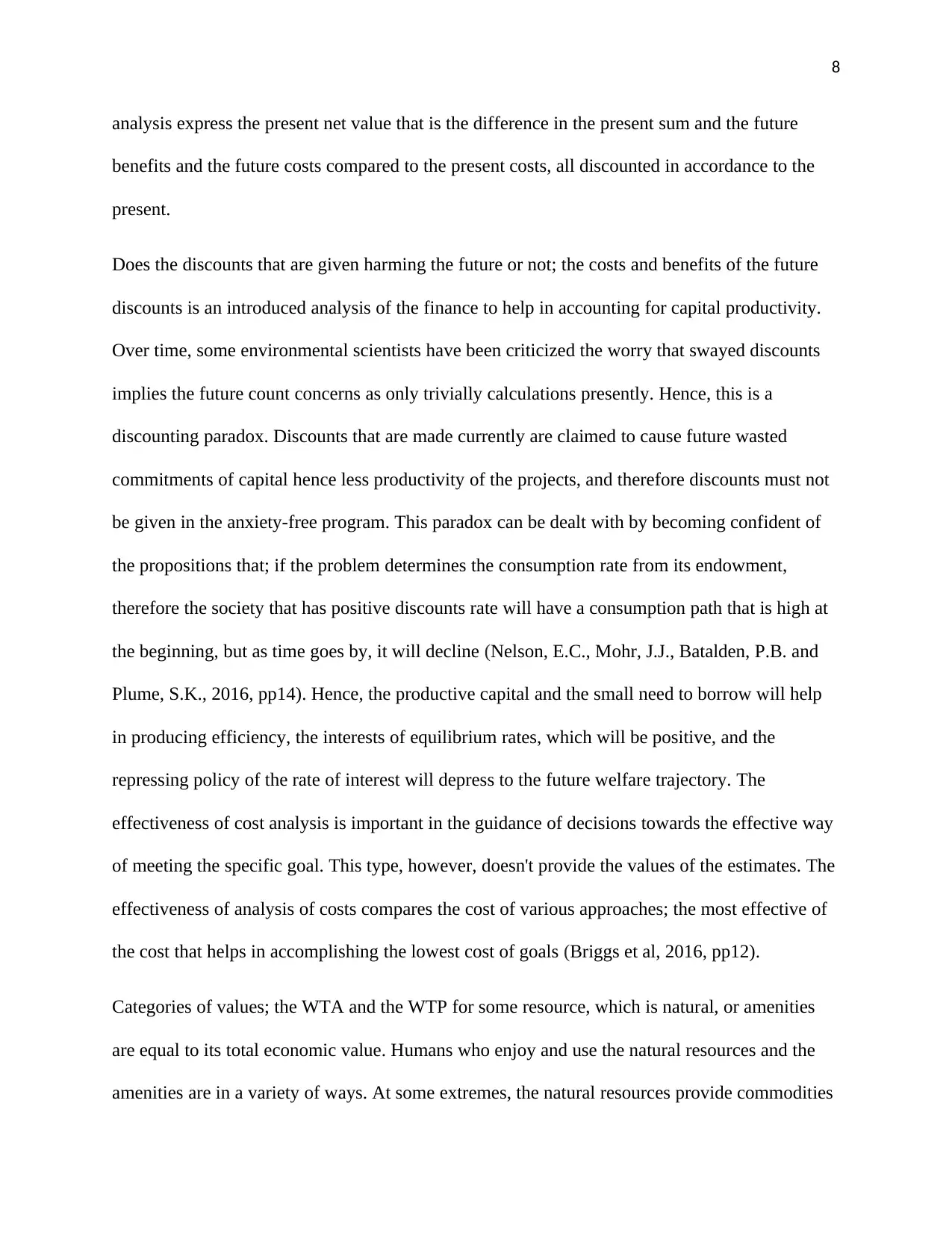
8
analysis express the present net value that is the difference in the present sum and the future
benefits and the future costs compared to the present costs, all discounted in accordance to the
present.
Does the discounts that are given harming the future or not; the costs and benefits of the future
discounts is an introduced analysis of the finance to help in accounting for capital productivity.
Over time, some environmental scientists have been criticized the worry that swayed discounts
implies the future count concerns as only trivially calculations presently. Hence, this is a
discounting paradox. Discounts that are made currently are claimed to cause future wasted
commitments of capital hence less productivity of the projects, and therefore discounts must not
be given in the anxiety-free program. This paradox can be dealt with by becoming confident of
the propositions that; if the problem determines the consumption rate from its endowment,
therefore the society that has positive discounts rate will have a consumption path that is high at
the beginning, but as time goes by, it will decline (Nelson, E.C., Mohr, J.J., Batalden, P.B. and
Plume, S.K., 2016, pp14). Hence, the productive capital and the small need to borrow will help
in producing efficiency, the interests of equilibrium rates, which will be positive, and the
repressing policy of the rate of interest will depress to the future welfare trajectory. The
effectiveness of cost analysis is important in the guidance of decisions towards the effective way
of meeting the specific goal. This type, however, doesn't provide the values of the estimates. The
effectiveness of analysis of costs compares the cost of various approaches; the most effective of
the cost that helps in accomplishing the lowest cost of goals (Briggs et al, 2016, pp12).
Categories of values; the WTA and the WTP for some resource, which is natural, or amenities
are equal to its total economic value. Humans who enjoy and use the natural resources and the
amenities are in a variety of ways. At some extremes, the natural resources provide commodities
analysis express the present net value that is the difference in the present sum and the future
benefits and the future costs compared to the present costs, all discounted in accordance to the
present.
Does the discounts that are given harming the future or not; the costs and benefits of the future
discounts is an introduced analysis of the finance to help in accounting for capital productivity.
Over time, some environmental scientists have been criticized the worry that swayed discounts
implies the future count concerns as only trivially calculations presently. Hence, this is a
discounting paradox. Discounts that are made currently are claimed to cause future wasted
commitments of capital hence less productivity of the projects, and therefore discounts must not
be given in the anxiety-free program. This paradox can be dealt with by becoming confident of
the propositions that; if the problem determines the consumption rate from its endowment,
therefore the society that has positive discounts rate will have a consumption path that is high at
the beginning, but as time goes by, it will decline (Nelson, E.C., Mohr, J.J., Batalden, P.B. and
Plume, S.K., 2016, pp14). Hence, the productive capital and the small need to borrow will help
in producing efficiency, the interests of equilibrium rates, which will be positive, and the
repressing policy of the rate of interest will depress to the future welfare trajectory. The
effectiveness of cost analysis is important in the guidance of decisions towards the effective way
of meeting the specific goal. This type, however, doesn't provide the values of the estimates. The
effectiveness of analysis of costs compares the cost of various approaches; the most effective of
the cost that helps in accomplishing the lowest cost of goals (Briggs et al, 2016, pp12).
Categories of values; the WTA and the WTP for some resource, which is natural, or amenities
are equal to its total economic value. Humans who enjoy and use the natural resources and the
amenities are in a variety of ways. At some extremes, the natural resources provide commodities
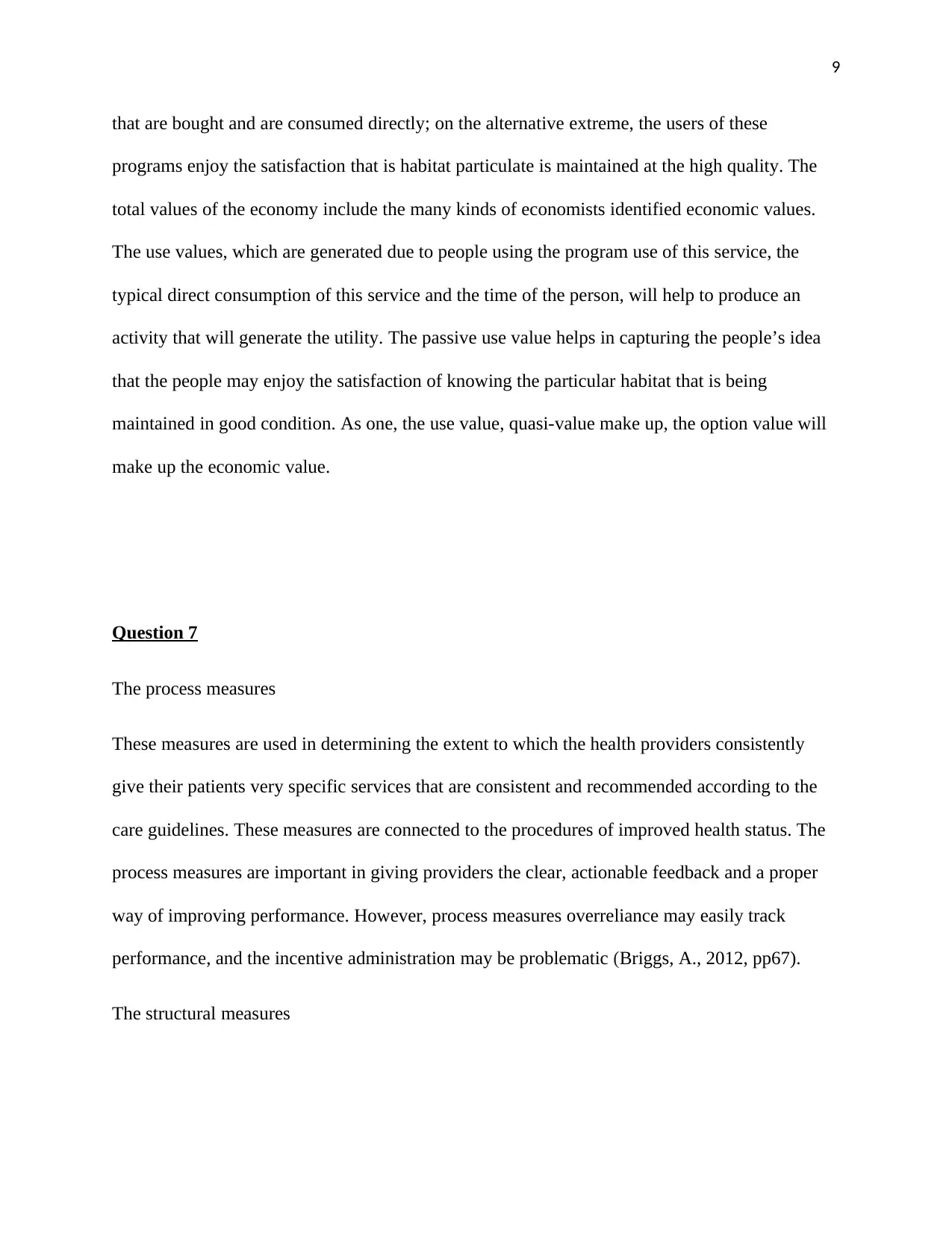
9
that are bought and are consumed directly; on the alternative extreme, the users of these
programs enjoy the satisfaction that is habitat particulate is maintained at the high quality. The
total values of the economy include the many kinds of economists identified economic values.
The use values, which are generated due to people using the program use of this service, the
typical direct consumption of this service and the time of the person, will help to produce an
activity that will generate the utility. The passive use value helps in capturing the people’s idea
that the people may enjoy the satisfaction of knowing the particular habitat that is being
maintained in good condition. As one, the use value, quasi-value make up, the option value will
make up the economic value.
Question 7
The process measures
These measures are used in determining the extent to which the health providers consistently
give their patients very specific services that are consistent and recommended according to the
care guidelines. These measures are connected to the procedures of improved health status. The
process measures are important in giving providers the clear, actionable feedback and a proper
way of improving performance. However, process measures overreliance may easily track
performance, and the incentive administration may be problematic (Briggs, A., 2012, pp67).
The structural measures
that are bought and are consumed directly; on the alternative extreme, the users of these
programs enjoy the satisfaction that is habitat particulate is maintained at the high quality. The
total values of the economy include the many kinds of economists identified economic values.
The use values, which are generated due to people using the program use of this service, the
typical direct consumption of this service and the time of the person, will help to produce an
activity that will generate the utility. The passive use value helps in capturing the people’s idea
that the people may enjoy the satisfaction of knowing the particular habitat that is being
maintained in good condition. As one, the use value, quasi-value make up, the option value will
make up the economic value.
Question 7
The process measures
These measures are used in determining the extent to which the health providers consistently
give their patients very specific services that are consistent and recommended according to the
care guidelines. These measures are connected to the procedures of improved health status. The
process measures are important in giving providers the clear, actionable feedback and a proper
way of improving performance. However, process measures overreliance may easily track
performance, and the incentive administration may be problematic (Briggs, A., 2012, pp67).
The structural measures
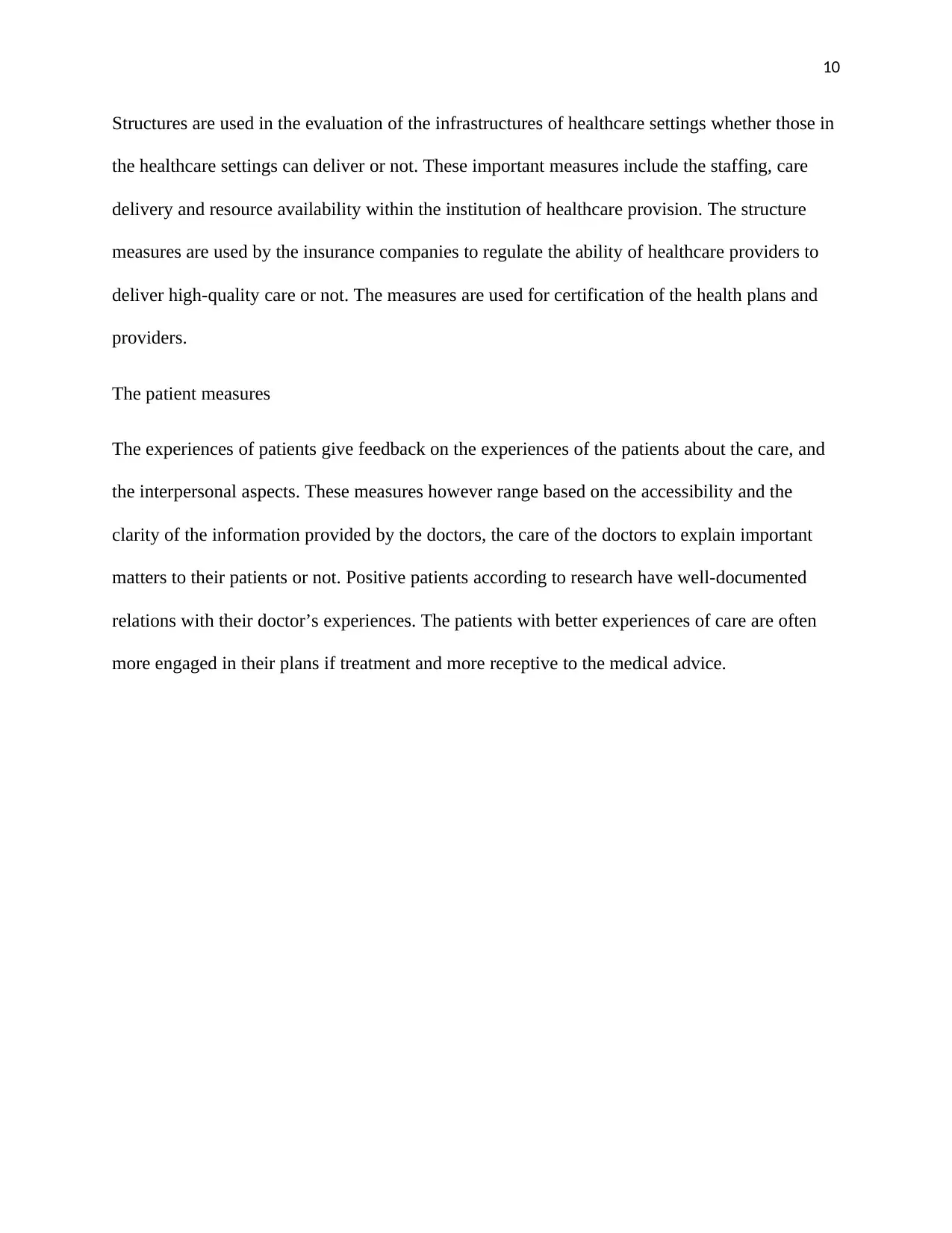
10
Structures are used in the evaluation of the infrastructures of healthcare settings whether those in
the healthcare settings can deliver or not. These important measures include the staffing, care
delivery and resource availability within the institution of healthcare provision. The structure
measures are used by the insurance companies to regulate the ability of healthcare providers to
deliver high-quality care or not. The measures are used for certification of the health plans and
providers.
The patient measures
The experiences of patients give feedback on the experiences of the patients about the care, and
the interpersonal aspects. These measures however range based on the accessibility and the
clarity of the information provided by the doctors, the care of the doctors to explain important
matters to their patients or not. Positive patients according to research have well-documented
relations with their doctor’s experiences. The patients with better experiences of care are often
more engaged in their plans if treatment and more receptive to the medical advice.
Structures are used in the evaluation of the infrastructures of healthcare settings whether those in
the healthcare settings can deliver or not. These important measures include the staffing, care
delivery and resource availability within the institution of healthcare provision. The structure
measures are used by the insurance companies to regulate the ability of healthcare providers to
deliver high-quality care or not. The measures are used for certification of the health plans and
providers.
The patient measures
The experiences of patients give feedback on the experiences of the patients about the care, and
the interpersonal aspects. These measures however range based on the accessibility and the
clarity of the information provided by the doctors, the care of the doctors to explain important
matters to their patients or not. Positive patients according to research have well-documented
relations with their doctor’s experiences. The patients with better experiences of care are often
more engaged in their plans if treatment and more receptive to the medical advice.
Secure Best Marks with AI Grader
Need help grading? Try our AI Grader for instant feedback on your assignments.
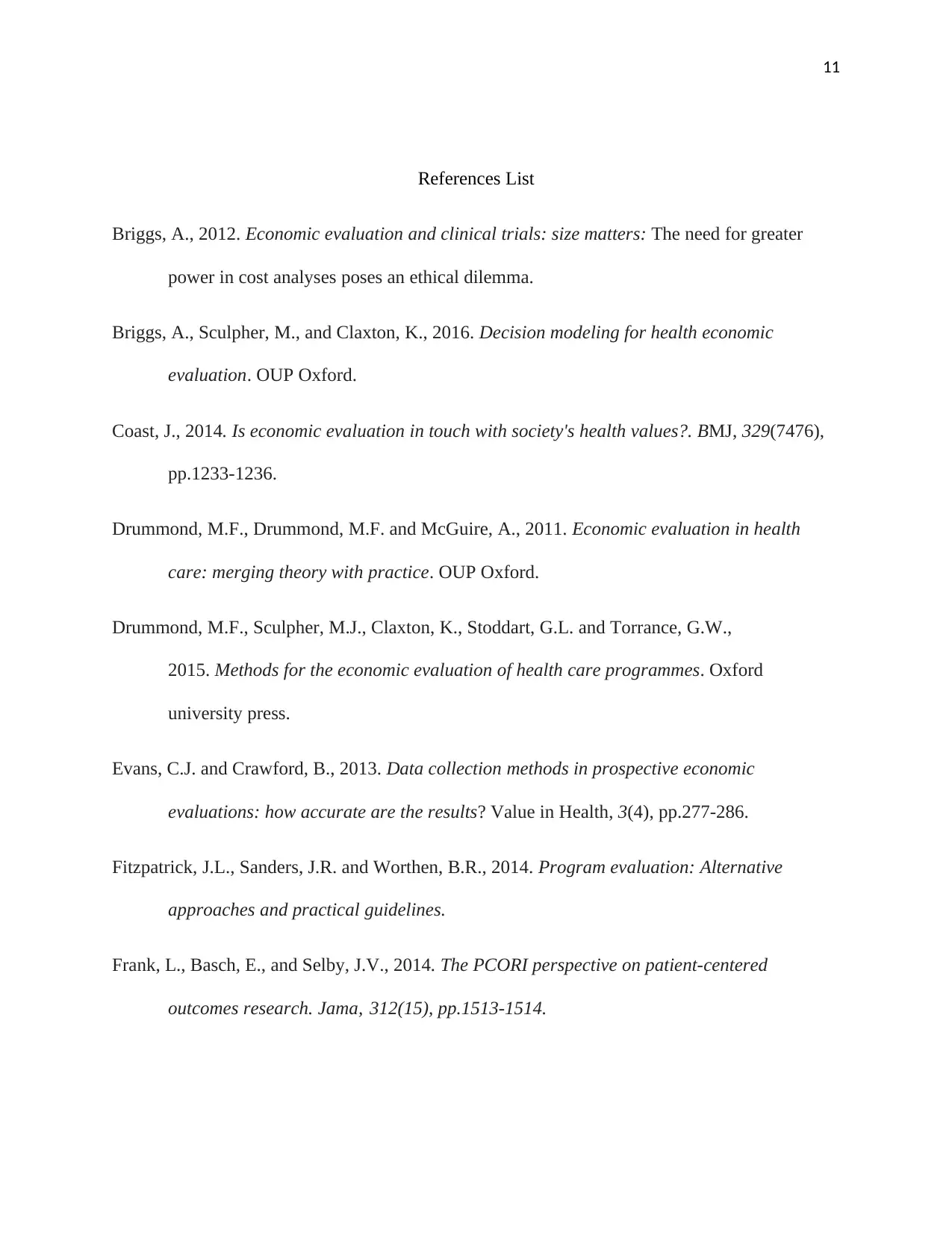
11
References List
Briggs, A., 2012. Economic evaluation and clinical trials: size matters: The need for greater
power in cost analyses poses an ethical dilemma.
Briggs, A., Sculpher, M., and Claxton, K., 2016. Decision modeling for health economic
evaluation. OUP Oxford.
Coast, J., 2014. Is economic evaluation in touch with society's health values?. BMJ, 329(7476),
pp.1233-1236.
Drummond, M.F., Drummond, M.F. and McGuire, A., 2011. Economic evaluation in health
care: merging theory with practice. OUP Oxford.
Drummond, M.F., Sculpher, M.J., Claxton, K., Stoddart, G.L. and Torrance, G.W.,
2015. Methods for the economic evaluation of health care programmes. Oxford
university press.
Evans, C.J. and Crawford, B., 2013. Data collection methods in prospective economic
evaluations: how accurate are the results? Value in Health, 3(4), pp.277-286.
Fitzpatrick, J.L., Sanders, J.R. and Worthen, B.R., 2014. Program evaluation: Alternative
approaches and practical guidelines.
Frank, L., Basch, E., and Selby, J.V., 2014. The PCORI perspective on patient-centered
outcomes research. Jama, 312(15), pp.1513-1514.
References List
Briggs, A., 2012. Economic evaluation and clinical trials: size matters: The need for greater
power in cost analyses poses an ethical dilemma.
Briggs, A., Sculpher, M., and Claxton, K., 2016. Decision modeling for health economic
evaluation. OUP Oxford.
Coast, J., 2014. Is economic evaluation in touch with society's health values?. BMJ, 329(7476),
pp.1233-1236.
Drummond, M.F., Drummond, M.F. and McGuire, A., 2011. Economic evaluation in health
care: merging theory with practice. OUP Oxford.
Drummond, M.F., Sculpher, M.J., Claxton, K., Stoddart, G.L. and Torrance, G.W.,
2015. Methods for the economic evaluation of health care programmes. Oxford
university press.
Evans, C.J. and Crawford, B., 2013. Data collection methods in prospective economic
evaluations: how accurate are the results? Value in Health, 3(4), pp.277-286.
Fitzpatrick, J.L., Sanders, J.R. and Worthen, B.R., 2014. Program evaluation: Alternative
approaches and practical guidelines.
Frank, L., Basch, E., and Selby, J.V., 2014. The PCORI perspective on patient-centered
outcomes research. Jama, 312(15), pp.1513-1514.
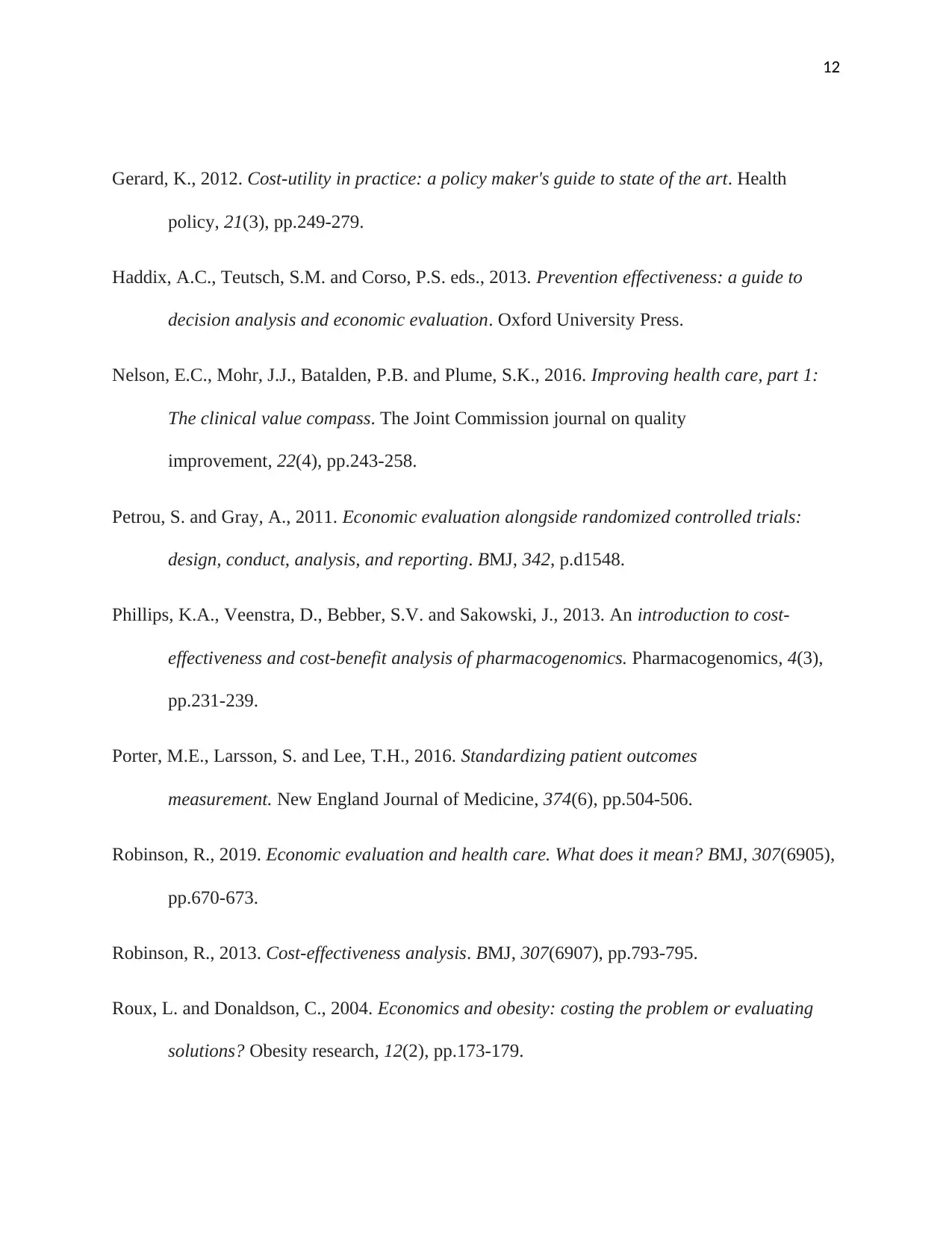
12
Gerard, K., 2012. Cost-utility in practice: a policy maker's guide to state of the art. Health
policy, 21(3), pp.249-279.
Haddix, A.C., Teutsch, S.M. and Corso, P.S. eds., 2013. Prevention effectiveness: a guide to
decision analysis and economic evaluation. Oxford University Press.
Nelson, E.C., Mohr, J.J., Batalden, P.B. and Plume, S.K., 2016. Improving health care, part 1:
The clinical value compass. The Joint Commission journal on quality
improvement, 22(4), pp.243-258.
Petrou, S. and Gray, A., 2011. Economic evaluation alongside randomized controlled trials:
design, conduct, analysis, and reporting. BMJ, 342, p.d1548.
Phillips, K.A., Veenstra, D., Bebber, S.V. and Sakowski, J., 2013. An introduction to cost-
effectiveness and cost-benefit analysis of pharmacogenomics. Pharmacogenomics, 4(3),
pp.231-239.
Porter, M.E., Larsson, S. and Lee, T.H., 2016. Standardizing patient outcomes
measurement. New England Journal of Medicine, 374(6), pp.504-506.
Robinson, R., 2019. Economic evaluation and health care. What does it mean? BMJ, 307(6905),
pp.670-673.
Robinson, R., 2013. Cost-effectiveness analysis. BMJ, 307(6907), pp.793-795.
Roux, L. and Donaldson, C., 2004. Economics and obesity: costing the problem or evaluating
solutions? Obesity research, 12(2), pp.173-179.
Gerard, K., 2012. Cost-utility in practice: a policy maker's guide to state of the art. Health
policy, 21(3), pp.249-279.
Haddix, A.C., Teutsch, S.M. and Corso, P.S. eds., 2013. Prevention effectiveness: a guide to
decision analysis and economic evaluation. Oxford University Press.
Nelson, E.C., Mohr, J.J., Batalden, P.B. and Plume, S.K., 2016. Improving health care, part 1:
The clinical value compass. The Joint Commission journal on quality
improvement, 22(4), pp.243-258.
Petrou, S. and Gray, A., 2011. Economic evaluation alongside randomized controlled trials:
design, conduct, analysis, and reporting. BMJ, 342, p.d1548.
Phillips, K.A., Veenstra, D., Bebber, S.V. and Sakowski, J., 2013. An introduction to cost-
effectiveness and cost-benefit analysis of pharmacogenomics. Pharmacogenomics, 4(3),
pp.231-239.
Porter, M.E., Larsson, S. and Lee, T.H., 2016. Standardizing patient outcomes
measurement. New England Journal of Medicine, 374(6), pp.504-506.
Robinson, R., 2019. Economic evaluation and health care. What does it mean? BMJ, 307(6905),
pp.670-673.
Robinson, R., 2013. Cost-effectiveness analysis. BMJ, 307(6907), pp.793-795.
Roux, L. and Donaldson, C., 2004. Economics and obesity: costing the problem or evaluating
solutions? Obesity research, 12(2), pp.173-179.
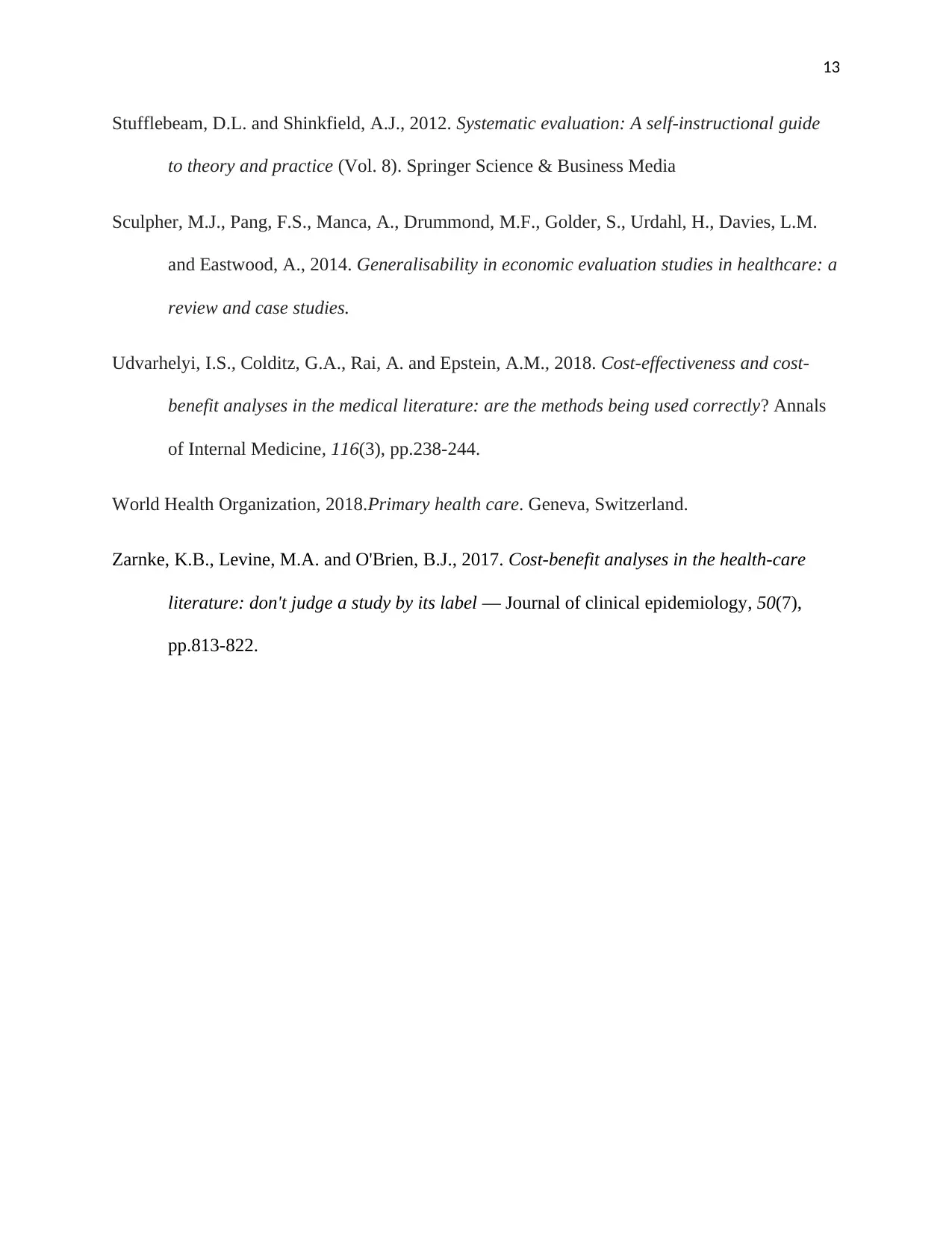
13
Stufflebeam, D.L. and Shinkfield, A.J., 2012. Systematic evaluation: A self-instructional guide
to theory and practice (Vol. 8). Springer Science & Business Media
Sculpher, M.J., Pang, F.S., Manca, A., Drummond, M.F., Golder, S., Urdahl, H., Davies, L.M.
and Eastwood, A., 2014. Generalisability in economic evaluation studies in healthcare: a
review and case studies.
Udvarhelyi, I.S., Colditz, G.A., Rai, A. and Epstein, A.M., 2018. Cost-effectiveness and cost-
benefit analyses in the medical literature: are the methods being used correctly? Annals
of Internal Medicine, 116(3), pp.238-244.
World Health Organization, 2018.Primary health care. Geneva, Switzerland.
Zarnke, K.B., Levine, M.A. and O'Brien, B.J., 2017. Cost-benefit analyses in the health-care
literature: don't judge a study by its label — Journal of clinical epidemiology, 50(7),
pp.813-822.
Stufflebeam, D.L. and Shinkfield, A.J., 2012. Systematic evaluation: A self-instructional guide
to theory and practice (Vol. 8). Springer Science & Business Media
Sculpher, M.J., Pang, F.S., Manca, A., Drummond, M.F., Golder, S., Urdahl, H., Davies, L.M.
and Eastwood, A., 2014. Generalisability in economic evaluation studies in healthcare: a
review and case studies.
Udvarhelyi, I.S., Colditz, G.A., Rai, A. and Epstein, A.M., 2018. Cost-effectiveness and cost-
benefit analyses in the medical literature: are the methods being used correctly? Annals
of Internal Medicine, 116(3), pp.238-244.
World Health Organization, 2018.Primary health care. Geneva, Switzerland.
Zarnke, K.B., Levine, M.A. and O'Brien, B.J., 2017. Cost-benefit analyses in the health-care
literature: don't judge a study by its label — Journal of clinical epidemiology, 50(7),
pp.813-822.
1 out of 13
Related Documents
Your All-in-One AI-Powered Toolkit for Academic Success.
+13062052269
info@desklib.com
Available 24*7 on WhatsApp / Email
![[object Object]](/_next/static/media/star-bottom.7253800d.svg)
Unlock your academic potential
© 2024 | Zucol Services PVT LTD | All rights reserved.





